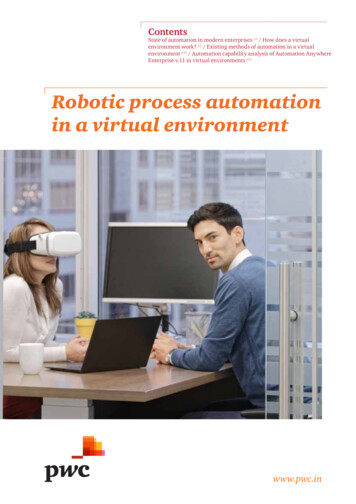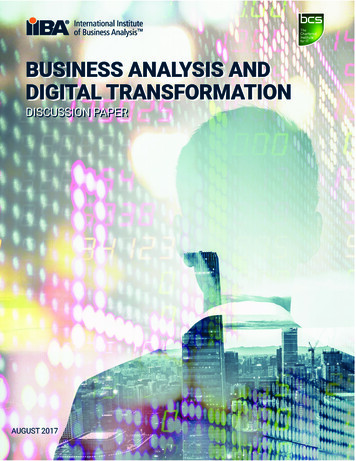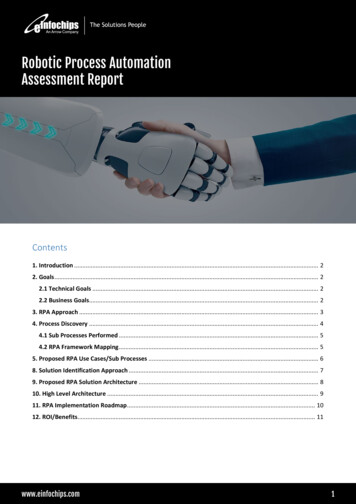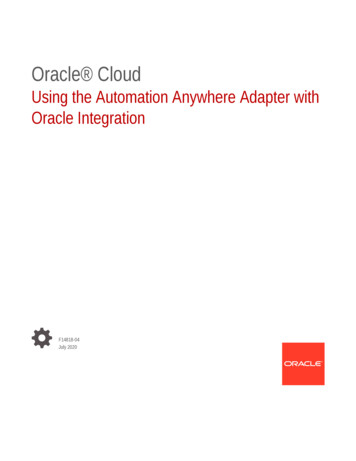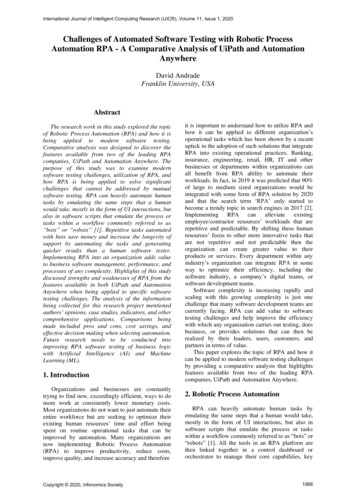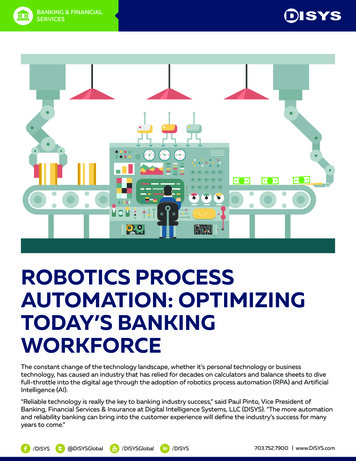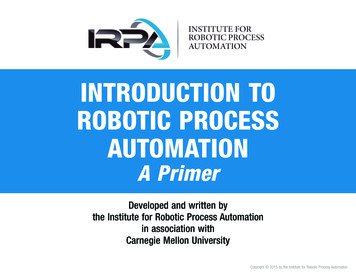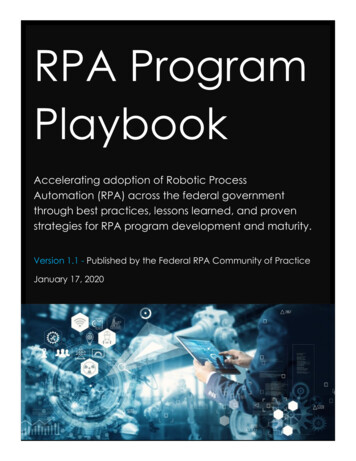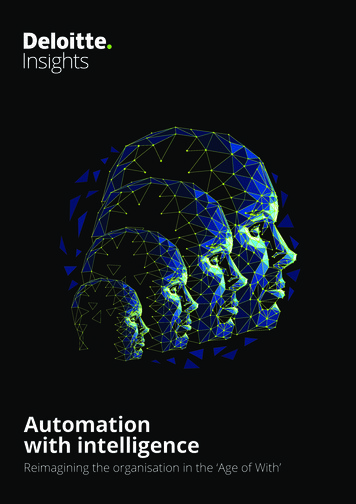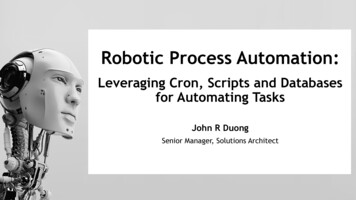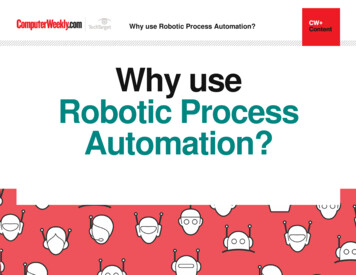
Transcription
Why use Robotic Process Automation?Why useRobotic ProcessAutomation?
Why use Robotic Process Automation?In this e-guideHow AntWorks is addressingthe pitfalls of RPAIn this e-guide:Robotic process automation (RPA) promises to helpenterprises eliminate labour intensive tasks, freeing upvaluable human resources to focus on activities that helporganisations differentiate themselves from competitors. Butdespite their potential, many RPA projects haven’t lived up toexpectations. Some industry studies have shown that mostRPA implementations have been unable to scale up as thebusiness grows, due in part to challenges such asorganisational barriers, process fragmentation and a widevariation of offline and online tasks. In this e-guide, read moreabout the state of RPA adoption in Asia-Pacific, how differentRPA players are addressing the needs of the market and what ittakes for RPA projects to deliver on the technology’s promises.Robotic process automationvendor teams with TechMahindraAaron Tan Executive Editor, APACWhat is robotic processautomation (RPA)?Robotics technology needs togo beyond automationIs the future of roboticprocess automationintelligent?APAC financial firms faceroadblocks with RPAPage 1 of 33
Why use Robotic Process Automation?In this e-guideWhat is robotic process automation (RPA)?What is robotic processautomation (RPA)?Robotics technology needs togo beyond automationIs the future of roboticprocess automationintelligent?APAC financial firms faceroadblocks with RPAHow AntWorks is addressingthe pitfalls of RPARobotic process automationvendor teams with TechMahindraPage 2 of 33Margaret Rouse, WhatIs.comRobotic process automation (RPA) is the use of software with artificialintelligence (AI) and machine learning capabilities to handle high-volume,repeatable tasks that previously required humans to perform. These tasks caninclude queries, calculations and maintenance of records and transactions.RPA technology consists of software robots (bots) that can mimic a humanworker. RPA bots can log into applications, enter data, calculate and completetasks and then log out. Currently, practitioners divide RPA technologies intothree broad categories: probots, knowbots and chatbots. Probots are bots that follow simple, repeatable rules to process data.Knowbots are bots that search the internet to gather and store userspecified information.Chatbots are virtual agents who can respond to customer queries in realtime.RPA software is not part of an organization's IT infrastructure. Instead, it sits ontop of it, enabling a company to implement the technology quickly and efficiently-- all without changing the existing infrastructure and systems. Whatdistinguishes RPA from traditional IT automation is the ability of the RPA
Why use Robotic Process Automation?In this e-guideWhat is robotic processautomation (RPA)?Robotics technology needs togo beyond automationIs the future of roboticprocess automationintelligent?APAC financial firms faceroadblocks with RPAHow AntWorks is addressingthe pitfalls of RPARobotic process automationvendor teams with TechMahindraPage 3 of 33software to be aware and adapt to changing circumstances, exceptions andnew situations. Once RPA software has been trained to capture and interpretthe actions of specific processes in existing software applications, it can thenmanipulate data, trigger responses, initiate new actions and communicate withother systems autonomously.Benefits of RPARobotic process automation technology can help organizations on their digitaltransformation journeys by: Enabling better customer service.Ensuring business operations and processes comply with regulationsand standards.Allowing processes to be completed much more rapidly.Providing improved efficiency by digitizing and auditing process data.Creating cost savings for manual and repetitive tasks.Enabling employees to be more productive.
Why use Robotic Process Automation?In this e-guideWhat is robotic processautomation (RPA)?Robotics technology needs togo beyond automationIs the future of roboticprocess automationintelligent?APAC financial firms faceroadblocks with RPAHow AntWorks is addressingthe pitfalls of RPARobotic process automationvendor teams with TechMahindraPage 4 of 33
Why use Robotic Process Automation?Applications of RPAIn this e-guideSome of the top applications of RPA include:What is robotic processautomation (RPA)?Robotics technology needs togo beyond automation Is the future of roboticprocess automationintelligent? APAC financial firms faceroadblocks with RPA How AntWorks is addressingthe pitfalls of RPARobotic process automationvendor teams with TechMahindraPage 5 of 33 Customer service: RPA can help companies offer better customerservice by automating contact centre tasks, including verifying esignatures, uploading scanned documents and verifying information forautomatic approvals or rejections.Accounting: Organizations can use RPA for general accounting,operational accounting, transactional reporting and budgeting.Financial services: Companies in the financial services industry can useRPA for foreign exchange payments, automating account openings andclosings, managing audit requests and processing insurance claims.Healthcare: Medical organizations can use RPA for handling patientrecords, claims, customer support, account management, billing,reporting and analytics.Human resources: RPA can automate HR tasks, including onboardingand offboarding, updating employee information and timesheetsubmission processes.Supply chain management: RPA can be used for procurement,automating order processing and payments, monitoring inventory levelsand tracking shipments.
Why use Robotic Process Automation?The evolution of RPAIn this e-guideWhat is robotic processautomation (RPA)?Robotics technology needs togo beyond automationIs the future of roboticprocess automationintelligent?APAC financial firms faceroadblocks with RPAHow AntWorks is addressingthe pitfalls of RPARobotic process automationvendor teams with TechMahindraPage 6 of 33Although the term "robotic process automation" can be traced to the early2000s, it had been developing for a number of years previously. RPA evolvedfrom three key technologies: screen scraping, workflow automation and artificialintelligence. Screen scraping is the process of collecting screen display datafrom a legacy application so that the data can be displayed by a more modernuser interface. The advantages of workflow automation software, whicheliminates the need for manual data entry and increases order fulfilment rates,include increased speed, efficiency and accuracy. Lastly, artificial intelligenceinvolves the ability of computer systems to perform tasks that normally requirehuman intervention and intelligence.Today, RPA software is particularly useful for organizations that have manydifferent and complicated systems that need to interact together fluidly. Forinstance, if an electronic form from a human resource system is missing a zipcode, traditional automation software would flag the form as having anexception and an employee would handle the exception by looking up thecorrect zip code and entering it on the form. Once the form is complete, theemployee might send it on to payroll so the information can be entered into theorganization's payroll system. With RPA technology, however, software that hasthe ability to adapt, self-learn and self-correct would handle the exception andinteract with the payroll system without human assistance.
Why use Robotic Process Automation?In this e-guideWhat is robotic processautomation (RPA)?Robotics technology needs togo beyond automationIs the future of roboticprocess automationintelligent?APAC financial firms faceroadblocks with RPAHow AntWorks is addressingthe pitfalls of RPARobotic process automationvendor teams with TechMahindraPage 7 of 33
Why use Robotic Process Automation?Top RPA vendorsIn this e-guide What is robotic processautomation (RPA)?Robotics technology needs togo beyond automationIs the future of roboticprocess automation intelligent? APAC financial firms faceroadblocks with RPAHow AntWorks is addressingthe pitfalls of RPARobotic process automationvendor teams with TechMahindraPage 8 of 33 Automation Anywhere Inc. provides an enterprise digital workforceplatform geared toward procure-to-pay, quote-to-cash, HR, claimsprocessing and other back-office processes.Blue Prism focuses on providing organizations in regulated industrieswith more agile virtual workforces, offering desktop-aligned robots thatare defined and managed centrally.EdgeVerve Limited, an Infosys company, helps enterprises modernizecustomer service, improve business processes and enhance operationalproductivity.HelpSystems enables companies to streamline IT and businessoperations by automating tasks and workflows without the need to writecode.UiPath offers an open platform to help organizations efficiently automatebusiness processes.Workfusion combines robotics, AI-powered cognitive automation andworkforce orchestration to automate enterprise business processes.
Why use Robotic Process Automation?What to look for in RPA softwareIn this e-guideWhat is robotic processautomation (RPA)?When enterprise leaders look for RPA technologies, they should consider anumber of things, including: Robotics technology needs togo beyond automation Is the future of roboticprocess automation intelligent?APAC financial firms faceroadblocks with RPAHow AntWorks is addressingthe pitfalls of RPARobotic process automationvendor teams with TechMahindraPage 9 of 33 Scalability: Organizations shouldn't select RPA software that requiresthem to deploy software robots to desktops or virtualized environments.They should look for RPA platforms that can be centrally managed andscale massively.Speed: Enterprises should be able to design and test new roboticprocesses in a few hours or less, as well as optimize the bots to workquickly.Reliability: As companies launch robots to automate hundreds or eventhousands of tasks, they should look for tools with built-in monitoring andanalytics that enable them to monitor the health of their systems.Simplicity: Organizations should look for products that are simpleenough that any employee in the business can build and use them tohandle various kinds of work, including collecting data and turningcontent into information that enables leaders to make the best businessdecisions.Intelligence: The best RPA tools can support simple task-basedactivities, read and write to any data source, and take advantage of moreadvanced learning to further improve automation.Enterprise-class: Companies should look for tools that are built from theground up for enterprise-grade scalability, reliability and manageability.
Why use Robotic Process Automation?C-level decision-making around RPAIn this e-guideWhat is robotic processautomation (RPA)?Robotics technology needs togo beyond automationIs the future of roboticprocess automationintelligent?APAC financial firms faceroadblocks with RPAHow AntWorks is addressingthe pitfalls of RPAThough automation software is expected to replace up to 140 million full-timeemployees worldwide by 2025, many high-quality jobs will be created for thosewho maintain and improve RPA software.When software robots do replace people in the enterprise, C-level executivesneed to be responsible for ensuring that business outcomes are achieved andnew governance policies are met.Robotic process automation technology also requires that the CTO/CIO takemore of a leadership role and assume accountability for the business outcomesand the risks of deploying RPA tools.Additionally, the COO, CIO and chief human resources officer, as well as therelevant C-level executive who owns the process being automated, should allwork toward ensuring the availability of an enterprise-grade, secure platform forcontrolling and operating bots across systems.Where the robotic process automation market is headingRobotic process automationvendor teams with TechMahindraPage 10 of 33A Global Market Insights Inc. report expects the RPA market to reach 5 billionby 2024. The increased adoption of RPA technologies by organizations toenhance their capabilities and performance and boost cost savings willreportedly drive the growth of the robotic process automation market mostduring that time.
Why use Robotic Process Automation?In this e-guideWhat is robotic processautomation (RPA)?Robotics technology needs togo beyond automationIs the future of roboticprocess automationintelligent?APAC financial firms faceroadblocks with RPAHow AntWorks is addressingthe pitfalls of RPARobotic process automationvendor teams with TechMahindraPage 11 of 33Next Article
Why use Robotic Process Automation?In this e-guideWhat is robotic processRobotics technology needs to go beyondautomationautomation (RPA)?Aaron Tan, Executive Editor, APACRobotics technology needs togo beyond automationIs the future of roboticprocess automationintelligent?APAC financial firms faceroadblocks with RPAHow AntWorks is addressingthe pitfalls of RPARobotic process automationvendor teams with TechMahindraRobots are good at performing repetitive tasks on factory floors today, but nextgeneration robotics will go beyond automation use cases, according to a leadingrobotics expert.“Traditionally, we thought about robots as repeating things that we tell them todo – and we’ve been pushing the science to go towards more autonomy,” saidSethu Vijayakumar, director of the Edinburgh Centre for Robotics.“But in my opinion, the next challenge is somewhere in between – where wewant to have robots that are able to make decisions on their own autonomously,but also be able to have humans in the loop.”Speaking at the ConnectGov Leaders Summit in Edinburgh, Vijayakumar saidnext-generation robots will collaborate with humans to solve “immediate socialproblems across domains” such as industrial safety, healthcare and disasterrelief.In industrial safety, for example, robots can be deployed in inaccessiblelocations to maintain public infrastructure.Page 12 of 33
Why use Robotic Process Automation?In this e-guideWhat is robotic process“We face significant challenges in terms of maintaining our infrastructure, suchas underground sewerage systems,” said Vijayakumar. “We are going to get toa stage where it is physically impossible for us to look at the integrity and safetyof these things.”automation (RPA)?Robotics technology needs togo beyond automationIs the future of roboticprocess automationintelligent?APAC financial firms faceroadblocks with RPAHow AntWorks is addressingthe pitfalls of RPARobotic process automationvendor teams with TechMahindraPage 13 of 33But it could take some time to get there even with the current pace oftechnological development, because of the uncertainties of the real world, andthe prevalence of noise and sensors in decision-making, said Vijayakumar.“Still, we have to really get to a stage where we can exploit the best of bothworlds,” he said. “Robots are very good at performing very precise motion, whilehumans are very good at contextual decision-making.”Some progress has been made, said Vijayakumar. Citing healthcare as anexample, he noted that while robots can play a significant role in cancersurgery, it is still surgeons who have the skills to make decisions on the types ofintervention to make in cancer treatment.“We want to use robotics as a way to provide more interesting visual aids tohelp identify the exact tumour locations using imaging technologies,” he said.“And that’s where we can bring the best of both worlds.”In the healthcare domain, Vijayakumar said exoskeletons can be used to helphumans in recovery, reducing the strain on national healthcare systems.
Why use Robotic Process Automation?In this e-guideWhat is robotic processautomation (RPA)?Robotics technology needs togo beyond automationIs the future of roboticprocess automationintelligent?“So instead of overloading the NHS, we can develop robotic systems to supportpeople to live healthy lives in a different way,” he said.According to market data from Research and Markets, the industrial roboticsmarket alone was valued at 18bn in 2018 and is expected to reach 40.8bn by2024, with a compound annual growth rate of 14.1% between 2019 and 2024.The market research firm cited the rising penetration of the internet of thingsand investments in robotics across regions as major contributors to the marketgrowth.For instance, the Made in China 2025 initiative was aimed at broadly upgradingthe Chinese industry by moving toward quality-focused and innovation-drivenmanufacturing, it said.APAC financial firms faceroadblocks with RPANext ArticleHow AntWorks is addressingthe pitfalls of RPARobotic process automationvendor teams with TechMahindraPage 14 of 33
Why use Robotic Process Automation?In this e-guideWhat is robotic processautomation (RPA)?Is the future of robotic process automationintelligent?John Moore, Senior Site EditorRobotics technology needs togo beyond automationIs the future of roboticprocess automationintelligent?APAC financial firms faceroadblocks with RPAHow AntWorks is addressingthe pitfalls of RPARobotic process automationvendor teams with TechMahindraPage 15 of 33The future of robotic process automation isn't what it used to be.When RPA became mainstream around 2015, cognitive RPA was consideredthe evolutionary path for the technology. Basic RPA was useful for automatingrepetitive tasks, but the rules-based approach worked best with structured data.The cognitive variety, however, would add optical character recognition (OCR),natural language processing (NLP) and machine learning to handle semistructured and unstructured data -- expanding the efficiencies of RPA to a widerrange of enterprise activities.RPA vendors since 2015 have indeed pushed RPA technology in the cognitivedirection, adding AI capabilities. But not everyone is convinced this is theultimate destination for the technology. Ron Schmelzer, managing partner andprincipal analyst at Cognilytica, a market research and advisory firm thatfocuses on AI and related fields such as RPA, believes intelligent processautomation, or IPA, is the shape of things to come.
Why use Robotic Process Automation?In this e-guideIPA diverges from RPA in that it goes far beyond recording a particular businessprocess and repeating it again and again. IPA aims to harness AI to learn howto adjust and improve the process flow, creating intelligent processes.What is robotic processautomation (RPA)?Robotics technology needs togo beyond automationIs the future of roboticprocess automationintelligent?APAC financial firms faceroadblocks with RPAHow AntWorks is addressingthe pitfalls of RPARobotic process automationvendor teams with TechMahindraPage 16 of 33'Unintelligent at its core'So, is infusing RPA with NLP and other technologies an exercise in pouring newwine into an old cask? Schmelzer seems to think so."Cognitive RPA is still RPA, which means, it's unintelligent at its core," he said."Simply using OCR or NLP or machine learning approaches doesn't make thesystems less cut-and-dried automated as they are now."Schmelzer isn't alone in this view of the future of robotic process automation.Management consultant McKinsey & Co. last year published an article on IPA,describing it as "an emerging set of new technologies that combinesfundamental process redesign with robotic process automation and machinelearning."Intelligent process automation, the article continued, augments the "[t]traditionallevers of rule-based automation with decision-making capabilities thanks toadvances in deep learning and cognitive technology."The result is "radically enhanced efficiency," according to McKinsey.
Why use Robotic Process Automation?The end of RPA?In this e-guideWhat is robotic processSmart IPA tools that adapt to new situations and expand beyond templated orrecorded activities "will supplant RPA of any sort," Schmeltzer contended.automation (RPA)?Robotics technology needs togo beyond automationIs the future of roboticprocess automationintelligent?APAC financial firms faceroadblocks with RPAHow AntWorks is addressingthe pitfalls of RPARobotic process automationvendor teams with TechMahindraPage 17 of 33That possible future of robotic process automation has yet to materialize,however. Cognilytica has created a scale to assess the capabilities of nextgeneration IPA systems. The yardstick starts at Level 0, which represents RPAproducts that have yet to embed AI, and peaks at Level 3, which representstechnology that can learn from itself to determine better ways to handle a givenprocess flow. At that stage, hard coding disappears and the system reliesentirely on machine learning.
Why use Robotic Process Automation?In this e-guideWhat is robotic processautomation (RPA)?Robotics technology needs togo beyond automationIs the future of roboticprocess automationintelligent?APAC financial firms faceroadblocks with RPAHow AntWorks is addressingthe pitfalls of RPARobotic process automationvendor teams with TechMahindraPage 18 of 33According to Cognilytica's assessment, no vendor or technology has reachedLevel 3."We are nowhere near that goal," said Kathleen Walch, managing partner andprincipal analyst at Cognilytica. "Some vendors have that [high-level IPA] in theirvision and are starting to realize the limits of RPA."
Why use Robotic Process Automation?In this e-guideWhat is robotic processWalch said some RPA vendors have reached Level 1 or 2. Level 1 capabilitiesinclude NLP and OCR, while Level 2 systems can automatically identify processflows in new systems and mitigate process flow exceptions, according toCognilytica.automation (RPA)?Robotics technology needs togo beyond automationIs the future of roboticprocess automationintelligent?Cognitive RPA as the future of robotic process automation isn't necessarily adead end for RPA vendor companies. Schmelzer said cognitive RPA tools that"embrace real data science," focus on "how the business process works" andare able to model and discover explicit and implicit business processes, canbecome intelligent process automation tools."IPA does require new technology, but it doesn't require new companies,"Schmelzer said.APAC financial firms faceroadblocks with RPAUiPath, an RPA vendor based in New York, is among the companies building AIinto their products. The company has reached Level 2 on Cognilytica's AI scale.How AntWorks is addressingthe pitfalls of RPA"Neural networking and machine learning should be embedded as part of anyprocess automation platform," said Param Kahlon, chief product officer atUIpath. "We see that process automation and AI go hand-in-hand."Robotic process automationvendor teams with TechMahindraPage 19 of 33Next Article
Why use Robotic Process Automation?In this e-guideWhat is robotic processAPAC financial firms face roadblocks withRPAautomation (RPA)?Aaron Tan, Executive Editor, APACRobotics technology needs togo beyond automationIs the future of roboticprocess automationintelligent?APAC financial firms faceroadblocks with RPAHow AntWorks is addressingthe pitfalls of RPARobotic process automationvendor teams with TechMahindraBanks and other financial institutions in the Asia-Pacific region are embracingrobotic process automation (RPA), but most have not been able to scale uptheir deployments.In addition, those that had tried to incorporate artificial intelligence (AI)capabilities into their automation tools have not realised the benefits of doing so.These were the findings of a new study by IDC, which monitored the automationprojects of over 30 early adopters of RPA. The technology analyst firm notedthat RPA is often the first step in a “continuum of technology-enabled initiativesthat will bring intelligence into the automation of business processes”.But when fully realised, IDC said automation, coupled with AI, will help financialfirms embrace what it calls an “intelligent digital workforce”, essentially softwarerobots that perform deterministic and non-deterministic tasks by continuouslyunderstanding and analysing structured and unstructured data.These robots represent rules and judgement-based automation, and, like theirhuman counterparts, they are both self-learning and self-healing workers thatPage 20 of 33
Why use Robotic Process Automation?In this e-guideWhat is robotic processautomation (RPA)?Robotics technology needs togo beyond automationIs the future of roboticprocess automationintelligent?APAC financial firms faceroadblocks with RPAHow AntWorks is addressingthe pitfalls of RPARobotic process automationvendor teams with TechMahindraPage 21 of 33can discover patterns to predict decisions and even offer recommendations toimprove them.Across the region, IDC noted that financial firms in Australia and Singaporehave been the forerunners in adopting an intelligent digital workforce, includingRPA, while those in India, South Korea, Thailand, Hong Kong, Malaysia,Indonesia and the Philippines are “fervently hoping to make the leap”.In choosing an automation supplier, IDC advised enterprises to base theirdecision on six core characteristics that will typically deliver more favourableresults.These include simplicity, usability, reusability by business users, ability todeliver enterprise-wide scale, and security and governance as the foundationaltenets. It should also include the availability of “real-time” operations analytics,an intelligence powered by AI technologies and innovative tools, and a strongsupport extended by the ecosystem.IDC added that the next two to three years will be crucial as more and morefinancial institutions reap significant benefits from implementation, and moresuccessful functional- and vertical-specific use cases are presented in themarket, with vendor offerings also becoming more advanced.Industry players at IDC’s annual Asian Financial Services Congress this yearagreed. Ron Goh, president for ASEAN and Korea at Automation Anywhere,
Why use Robotic Process Automation?In this e-guideWhat is robotic processautomation (RPA)?Robotics technology needs togo beyond automationIs the future of roboticprocess automationintelligent?APAC financial firms faceroadblocks with RPAHow AntWorks is addressingthe pitfalls of RPARobotic process automationvendor teams with TechMahindraPage 22 of 33said during a panel discussion that while most banks are still in the early stagesof adopting RPA, there will be huge adoption in the next three to five years.“If you can help a worker do something in half the time so he can do somethingelse, you can expect productivity gains and cost savings,” he said. “And oncethat is proven, [the RPA market] will skyrocket.”At Sri Lanka’s People’s Bank, a state-owned commercial bank, employingautomation tools had freed up its tellers to focus on supporting the bank’s 52digital branches where customers can be onboarded in less than 10 minutes.“We’ve converted tellers into digital agents who are now trained on our digitalservices and focused on digital enablement across the bank,” said PriyanthaEdirisinghe, CIO of People’s Bank.By 2021, IDC expects 60% of top-tier banks and insurance firms in the AsiaPacific region to deploy intelligent digital workforce offerings for increasedautomation, intelligent decision making and improved operational efficiencies.Next Article
Why use Robotic Process Automation?In this e-guideWhat is robotic processHow AntWorks is addressing the pitfalls ofRPAautomation (RPA)?Aaron Tan, Executive Editor, APACRobotics technology needs togo beyond automationIs the future of roboticprocess automationintelligent?APAC financial firms faceroadblocks with RPAHow AntWorks is addressingthe pitfalls of RPARobotic process automationvendor teams with TechMahindraPage 23 of 33Robotic process automation (RPA) should be part of a larger strategy to driveautomation across the enterprise, and those that just focus on RPA tools aresetting themselves up for failure, according to a top executive at Singaporebased AntWorks.Speaking to Computer Weekly in an exclusive interview, Asheesh Mehra, cofounder and group CEO of AntWorks, said most RPA initiatives today arefocused on automating tasks rather than business processes, making it hard forenterprises to scale their deployments across an organisation.Citing a KPMG study which found that most automation initiatives have notgone beyond 10 bots, Mehra said RPA tools need to be augmented with deepermachine learning (ML) capabilities in order to be effective.That is the premise behind AntWorks, a single “integrated automation platform”that offers ML-infused RPA capabilities to help enterprises automate entirebusiness processes rather than tasks.
Why use Robotic Process Automation?In this e-guideA key aspect of the AntWorks platform is its ability to understand and process alarge variety of data, which Mehra said is the most critical component inautomating a back office process.What is robotic processautomation (RPA)?Robotics technology needs togo beyond automationIs the future of roboticprocess automationintelligent?While other RPA suppliers might use optical character recognition (OCR)technology to extract structured and semi-structured data, AntWorks built itsown data ingestion engine as it wanted high precision rates to avoid the need tohandle exceptions in data processing.“The cleaner the data, or the more curated your data is, the less likely you willget an exception downstream. That’s when true cost benefits start kicking in forenterprises,” said Mehra.Cognitive machine readingAPAC financial firms faceroadblocks with RPAHow AntWorks is addressingthe pitfalls of RPAUsing what Mehra dubbed as “cognitive machine reading”, AntWorks’ dataingestion engine can read structured, unstructured, images and inferred data,the last of which refers to derived data about relationships between entities thathave not have
user interface. The advantages of workflow automation software, which . Automation Anywhere Inc. provides an enterprise digital workforce . Why use Robotic Process Automation? In this e-guide What is robotic process
